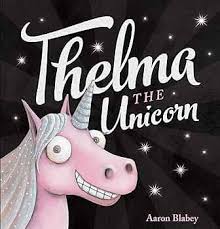Thelma the Unicorn
- context: Array
- icon:
- icon_position: before
- theme_hook_original: google_books_biblio

Thelma the Unicorn
And when he asked about her trip
Beneath their favourite tree,
She simply said, “Oh, it was fun…
But I’d rather just be me.”
What young child hasn’t wished to be special and handsome/pretty? However, in
Thelma the Unicorn, Blabey presents a delightful story about accepting that you are perfect the way you are.
Thelma is an ordinary looking horse who desperately wants to be a unicorn so that she will be special and beautiful. Thelma’s best friend, Otis the donkey, tries to tell her that she is perfect the way she is, but Thelma is forlorn and sad. She ties a carrot on her forehead, hoping that others might believe she is a unicorn. One day, a truck driver, shocked at the sight of a unicorn, swerves and spills pink, sparkly paint all over Thelma, making her look like the unicorn she wants to be. She soon becomes famous and beloved by unicorn fans all over. At first, she’s thrilled, but then she becomes lonely. She remembers her best friend, washes off the paint and sparkles, and reunites with Otis under their favourite tree.
The book design and illustrations are gorgeous! Pink and sparkly appeals to younger audiences, and I love the tactile title on the book cover. The endpaper and flyleaf are adorable pink, matching the unicorn’s paint colour. The illustrations are realistic and yet cartoon-like and do a fantastic job at capturing the facial expressions and body language of the characters. My favorites are the look of love and concern Otis gives Thelma when she is upset and the looks of horror on the faces of the truck driver and Otis when the truck swerves too sharply. The one area of concern is the use of “OMG” in one of the illustrations. While this is a common expression, some parents might not appreciate this phrase being included in a book for young children.
The text, mainly in four line groupings with lines two and four that rhyme, gives parents and teachers an opportunity to engage children in phonemic awareness development by finding and playing with words that rhyme. This activity develops pre-reading skills in young children. The author draws the reader in and gets the reader to empathize with Thelma with the words he uses and illustrations that zoom in and out in different perspectives.
Karina Wiebenga is a grade 4 educator in Burnaby, British Columbia.
